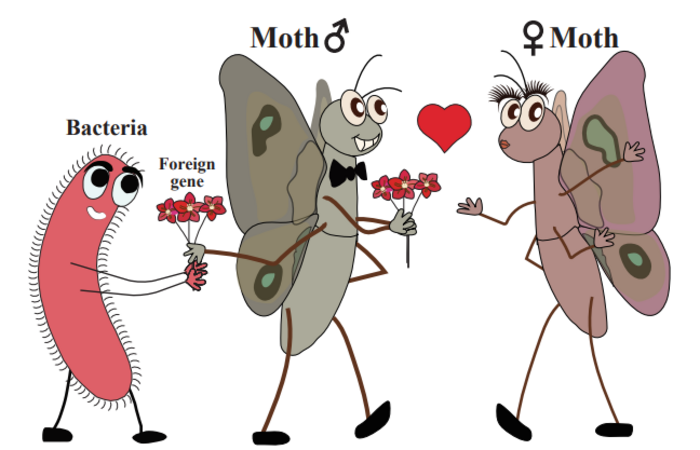Hundreds of millions of years ago, microbes and plants might have given insects an evolutionary advantage by passing genes to them through horizontal gene transfer. In a study published in the journal Cell on July 18, researchers report that more than 1,400 genes across 218 insect species, including butterflies and moths, that originated from bacteria, viruses, fungi, and plants. The study argues that these genes might have been essential for insect evolution by allowing them to develop beneficial traits in mating behavior, nutrition, growth, and adaptation to environmental changes.

Credit: Yang Li Liu & Xing Xing Shen
Hundreds of millions of years ago, microbes and plants might have given insects an evolutionary advantage by passing genes to them through horizontal gene transfer. In a study published in the journal Cell on July 18, researchers report that more than 1,400 genes across 218 insect species, including butterflies and moths, that originated from bacteria, viruses, fungi, and plants. The study argues that these genes might have been essential for insect evolution by allowing them to develop beneficial traits in mating behavior, nutrition, growth, and adaptation to environmental changes.
Horizontal gene transfer (HGT) is fairly common between microbes. For example, bacteria use this mechanism to transmit antibiotic-resistance genes between species, but scientists more recently have been systematically looking at the phenomenon between insects and microbes or plants.
“Previous studies have shown that HGT may have contributed to insect biodiversity, but nobody knew how large a role it plays in this process,” says senior author Xing-Xing Shen (@shenxingxing1), an evolutionary biologist at Zhejiang University in Hangzhou, China. “Since there are a lot of high-quality insect genomes available for our analysis, I thought that now is a good time to systematically investigate how prevalent HGT is in insects.”
Shen’s team at Zhejiang University started this project in collaboration with Antonis Rokas, an evolutionary biologist at Vanderbilt University by gathering 218 high-quality insect genome samples representing 11 of 19 species-rich orders of insects. With the data, they were able to draw an evolutionary tree, identify out-of-place genes that are more commonly found in non-animal genomes, and examine what factors contribute to the fate of HGT in insects.
“There were HGT events everywhere we looked,” says Shen. “However, we don’t know whether these transfers of genes are beneficial to the insects, or even the functions for most of these genes,” says Shen. He enlisted help from another expert—Jianhua Huang, who studies insect gene functions at Zhejiang University.
“Shen walked into my office with a list of more than 1,400 genes, and we had to decide where to start,” Huang says. The team decided to validate the function of the most prevalent foreign gene without known functions in insects: LOC105383139.
“This gene was horizontally introduced into nearly all moths and butterflies from a donor in the bacterial genus Listeria,” they report in the study, meaning this gene has persisted in the genome since the time of moths’ and butterflies’ common ancestor more than 300 million years ago.
They decided to delete this ancient gene from diamondback moths, a pest affecting broccoli and cabbage, and observe what kind of functions it has. “Surprisingly, we saw those moths lacking this gene cannot produce many viable eggs,” Huang says. “Then, we found that the gene influences the male courtship behavior.”
The group plans on doing more research about the mechanisms behind how this gene helps insects to mate more effectively and whether it can be exploited as a pest-control tool.
###
This work was in part supported by the National Natural Science Foundation of China, the U.S. National Science Foundation, and the U.S. National Institutes of Health.
Cell, Li et al. “HGT is widespread in insects and contributes to male courtship in lepidopterans” https://www.cell.com/cell/fulltext/S0092-8674(22)00719-X
Cell (@CellCellPress), the flagship journal of Cell Press, is a bimonthly journal that publishes findings of unusual significance in any area of experimental biology, including but not limited to cell biology, molecular biology, neuroscience, immunology, virology and microbiology, cancer, human genetics, systems biology, signaling, and disease mechanisms and therapeutics. Visit http://www.cell.com/cell. To receive Cell Press media alerts, contact [email protected].
Journal
Cell
DOI
10.1016/j.cell.2022.06.014
Method of Research
Experimental study
Subject of Research
Animals
Article Title
HGT is widespread in insects and contributes to male courtship in lepidopterans
Article Publication Date
18-Jul-2022




